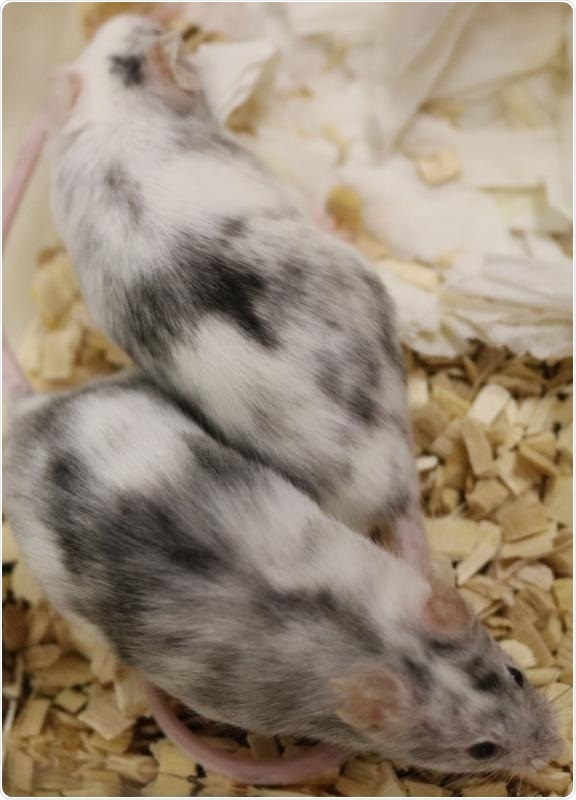Researchers from the Francis Crick Institute along with the University of Kent utilized gene-editing technology to produce male-only and female-only mice litter with 100% efficacy.

The black coat of the mouse refers to the genetically modified cells, the white is the non-modified cells. The researchers breed these animals to produce offspring which are 100% genetically modified, containing one half of CRISPR-Cas9. Image Credit: The Francis Crick Institute.
This proof of principle research reveals how the technology can be utilized to enhance animal welfare in scientific research and also in agriculture. The research was published on December 3rd, 2021, in the Nature Communications journal.
Farming and scientific studies mostly require either female or male animals. For instance, lab research into female or male reproduction needs only animals of the particular sex being investigated. In farming, only female animals are needed in dairy herds and for egg production. This indicates that it is a general practice for animals of the non-essential sex to be culled after birth.
The novel technique by scientists utilizes a two-part genetic system to inactivate embryos soon after fertilization, facilitating the development of the desired sex. This method that is genetically based to control the offspring’s sex can dramatically decrease culling in both industries.
The embryo selection depends on the fact that there are two elements of CRISPR-Cas9—the Cas9 enzyme that cleaves the DNA, enabling researchers to change specific regions, and the guide RNA which transports the Cas9 to the correct location on the genome.
The researchers placed one element of the system on the father’s Y or X chromosome, which means that it would be inherited only by males or females respectively. The other element contributed by the mother is inherited by all embryos.
The researchers targeted the Top1 gene—vital for DNA repair and replication. Upon embryo formation from a sperm and egg, each containing one-half of CRISPR-Cas9, the gene-editing was induced in the embryo and could not develop beyond the initial stage of around 16 to 32 cells.
With this technique, the scientists could control, with 100% efficiency, the sex of a litter. To create a male-only litter, the scientists edited the father’s X chromosome, which means that the females alone inherited the deleterious mutation, and for a female-only litter, they edited the Y chromosome.
Astonishingly, this technique did not result in a 50% decrease in the number of offspring produced. But the litter sizes were between 61%–72% of the control litters. The scientists reveal that this is because animals like mice produce more eggs than needed during each ovarian cycle, enabling a proportion of them to be lost at the time of early development without reducing litter size.
This indicates that in instances where single-sex is needed, fewer breeding animals would be needed to produce the same number of the desired sex of offspring.
The Top1 gene is conserved well across mammals and hence these results might also apply to other animals.
This method works as we split the genome editing process in half, between a male and female, and it is only when the two halves meet in an embryo through breeding, that it is activated. Embryos with both halves cannot develop beyond very early cell stages. We’ve also shown this process works successfully in different combinations—introducing either the Cas9 or the guide RNA elements onto the mother’s or father’s chromosomes.”
Charlotte Douglas, Study First Author and Postdoctoral Scientist, Francis Crick Institute
Charlotte Douglas was a former PhD student at the Francis Crick Institute
Since the offspring that survives contains only half of the CRISPR-Cas9 elements within their genome, this functions as a control impeding the sex selection being passed down to further generations unless these offsprings are selectively bred with the opposite sex having the other half. This is diverse to genetic engineering through “gene-drive” techniques, which spreads a genetic mutation broadly in a population.
The surviving offspring did not have any harmful impacts from the gene edit.
This work could have an immediate and valuable impact in scientific laboratories, as we’ve shown how it is safe and effective in mice, a common mammal used in medical and scientific research. While a lot of research needs both sexes, there are areas of study where only one is needed. For example, when studying the reproductive system, sex-specific diseases, or certain hormones.”
James Turner, Study Author and Group Leader, Sex Chromosome Biology Laboratory, Francis Crick Institute
“The implications of this work are potentially far-reaching when it comes to improving animal welfare, but should be considered at ethical and regulatory levels,” adds Peter Ellis, author and senior lecturer in molecular genetics and reproduction at the University of Kent.
In particular, before any potential use in agriculture, there would need to be extensive public conversation and debate, as well as changes to legislation. On the scientific side, there is also much work to be done over a number of years. Further research is needed, first to develop the particular gene-editing toolkits for different species, and then to check they are safe and effective.”
Peter Ellis, Study Author and Senior Lecturer, Molecular Genetics and Reproduction, University of Kent
Source:
Journal reference:
Douglas, C., et al. (2021) CRISPR-Cas9 effectors facilitate generation of single-sex litters and sex-specific phenotypes. Nature Communications. doi.org/10.1038/s41467-021-27227-2.